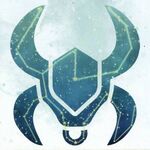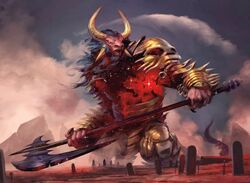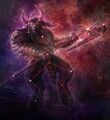Mogis
| Mogis | |
|---|---|
| God of Slaughter | |
| Information | |
| Colors |
|
| Species | God |
| Birth, Life & Death | |
| Birthplace | Theros |
| Family | |
| Relatives | Iroas (twin brother) |

Mogis (/moʊgɪs/, MOH-gihs[1]) is the God of Slaughter, Violence, and War on Theros. He is associated with black and red mana. Mogis embodies uncontrolled rage, cruelty, and bloodlust, acting as the dark counterpart and twin brother of the god Iroas, who represents honorable victory in battle. He is feared for inspiring savage violence and unrestrained wrath among mortals, especially warriors. His followers are often consumed by rage, sacrificing honor and compassion to wield his destructive power.
Description
Mogis appears as a massive, four-horned minotaur clad in spiked bronze armor, wielding a huge ebon greataxe. Unlike other gods who may take various forms, Mogis does not disguise himself; to see him is to witness the cruelty and savagery of war personified. His presence radiates palpable anger and malice, and he exercises no restraint over his temper, lashing out even at subordinates. His "red eye" is a common profanity in Meletis, relating to violent death, and Akroan warriors are cautioned against giving in to his seductive bloodlust, lest they become androphages—mindless killers consumed by his fury.
Mogis governs warfare alongside his brother Iroas, but where Iroas values honor and victory, Mogis revels in sadism, destruction, and the utter humiliation of enemies. He drives warriors toward cruelty and bloodthirst, exploiting their hatred to fuel his power. While soldiers fear losing themselves to Mogis's rage and dishonoring themselves, those who are vengeful or forsaken call upon him to grant them the strength of rage.
Influence and Goals
Mogis encourages violence, cruelty, and malice in warfare. He sees hatred as a source of strength and lures warriors into rage to overcome fear in battle. However, this comes at the cost of their honor, decency, and compassion. He values destruction over glory and views the world as a canvas to be painted with blood. His ultimate goal is the total ruin of mortal society and the death of his brother Iroas, after which he would reign uncontested.
Mogis is incapable of loyalty, treating any divine alliances as temporary tools to further his ends. He shares a functional relationship with Erebos, who appreciates that Mogis's destructive desire brings souls to the underworld. Erebos also manipulates Mogis to disrupt the schemes of Heliod, which draws Iroas into conflict, perpetuating their endless war.
Mogis holds respect for Phenax due to the chaos Phenax causes, which fuels Mogis's destructive tendencies. Conversely, he harbors deep disdain for Ephara and Karametra, resenting Ephara's orderly cities and adherence to rules, as well as Karametra’s aid to the weak, whom Mogis views as unworthy. He enjoys destroying fertile fields, provoking harsh retaliations from Karametra.
Worship
Mogis’s followers are devoted to channeling hatred and rage into acts of violence and cruelty. They value deeds over words, making his cult active and dangerous. Worshippers range from vengeful lovers to bloodthirsty warriors, all honoring Mogis through bloody offerings.
Minotaurs are the most fervent devotees, holding brutal rites and war chants that incite frenzy before battle. The appearance of the blood moon, representing Mogis’s crimson eye, is a particularly sacred occasion. On such nights, followers hold feasts of raw or barely cooked meat and consume intoxicants, often performing ritual self-mutilation to demonstrate their devotion.
History
Like all the gods of Theros, Mogis was silenced during the Silence of the Gods, rendering him unable to influence mortal battles.[2] However, he circumvented this restriction by secretly aiding his oracle Rhordon during a duel with Anax, shortly before the Great Revel.[3]
Mogis's existence is defined by his eternal rivalry with Iroas, and many myths emphasize their antagonism and twinship. Mogis desires to destroy Iroas and become the sole god of war. His actions are driven by this goal, seeking to unmake the world through savagery and bloodshed, believing that only the strongest should survive. He hopes to see the polis fall and mortal civilization burned to ashes.
Inspiration
The character of Mogis is inspired by a partial aspect of Ares, the Greek god of war. But he is closer to Ares' sons Deimos ("Dread") and Phobos ("Fear") and Ares' wife Enyo, goddess of war, destruction, conquest, and bloodlust. His appearance is inspired by the Minotaur.
Gallery
-
Mogis and Iroas
Story appearances
In-game references
- Represented in:
- Associated cards:
- Depicted in:
- Quoted or referred to:
References
- ↑ Wizards of the Coast (September 26, 2013). "Theran Pronunciation Quiz". magicthegathering.com. Wizards of the Coast. Archived from the original on 2021-04-30.
- ↑ Jenna Helland (April 2014). "Theros: Godsend, Part I." Wizards of the Coast. ISBN 978-0-7869-6556-4.
- ↑ Jenna Helland (May 2014) – Journey into Nyx: Godsend, Part II, Wizards of the Coast.
External links
- The Magic Creative Team (January 29, 2014). "The Gods of Born of the Gods". magicthegathering.com. Wizards of the Coast. Archived from the original on 2019-05-06.
- Trick Jarrett (January 10, 2014). "Looking at Mogis". magicthegathering.com. Wizards of the Coast. Archived from the original on 2020-11-11.
- Mike McArtor (March 24, 2014). "Born's Gods". magicthegathering.com. Wizards of the Coast. Archived from the original on 2021-04-29.
- Trick Jarrett (May 02, 2014). "Dictate of the Twin Gods". magicthegathering.com. Wizards of the Coast. Archived from the original on 2020-11-12.


